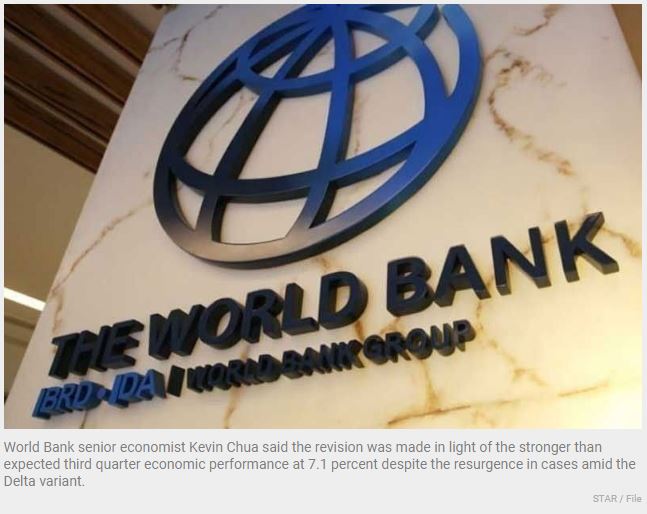World Bank raises Philippines growth forecast
MANILA, Philippines — The Philippines is set for a strong rebound this year as momentum picks up, but economic scarring will likely hamper growth in the coming years and fall below government expectations, the World Bank said.
In an economic update yesterday, the multilateral lender raised its 2021 gross domestic product (GDP) growth forecast for the country to 5.3 percent, higher than its 4.3 percent projection in September.
World Bank senior economist Kevin Chua said the revision was made in light of the stronger than expected third quarter economic performance at 7.1 percent despite the resurgence in cases amid the Delta variant.
Chua said domestic activity was less prone to infections, as households and firms learned to cope with infections and diminished mobility.
“Initially, we thought this would impact growth even further, but then what happened is that mobility was not really hampered. And we understand that the government is opening things up in the fourth quarter,” he said.
World Bank’s latest forecast is now above the government’s revised GDP growth target of four to five percent for the whole year. The economy is coming off a 9.6 percent contraction in 2020.
However, the Washington-based lender appears to be less bullish than the government in the coming years.
The World Bank is looking at a 5.9 percent growth in 2022 and 5.7 percent in 2023, significantly lower than the seven to nine percent expectation from the government.
Chua explained that the World Bank is seeing cases of economic scarring in the country, as many businesses in the Philippines have already closed due to the pandemic, resulting in jobs and income losses.
He added that cases of health insecurities, especially among the poor, and the disruption in education are also factors considered that would likely affect productivity and human capital.
Prior to the pandemic, the World Bank estimated the potential GDP growth of the Philippines at around 6.1 percent, but COVID-19 brought this down to 5.7 percent.
“So between 2021 to 2029, we can expect long-term growth somewhere around 5.7 percent. But that does not mean that it’s cast in stone,” Chua said.
“If we can pursue digitalization, it could even drive our potential GDP. There are many good things that can still happen so long as the government and the incoming administration could focus on productivity enhancing policies,” he said.
Alongside the progress in vaccination, the World Bank emphasized that the domestic economy will further reopen, allowing for a return of market confidence, and more dynamic economic activity.
Public investment is also expected to be a key growth driver in the medium term, as the government is expected to pursue its infrastructure investment agenda, while private investment remains tepid due to subdued lending and market uncertainty.
The World Bank said household consumption is projected to recover, as remittances pick up and employment slowly improves, barring new episodes of case resurgence and sudden hikes in inflation.
It noted that reforms that open more sectors to foreign investments, streamline administrative procedures to facilitate market entry and encourage firms to adopt new technology are measures that can boost private sector growth, create more jobs, and strengthen recovery.
Despite encouraging trends, the World Bank’s latest economic update maintained that the pandemic is still a major risk to the country’s growth prospects.
Chua said speeding up vaccination especially in areas outside the capital and sustaining the observance of health protocols are important in reviving the economy.
“Social protection measures including the country’s cash transfer programs remain important to mitigate the adverse impact of the pandemic on livelihoods, health, and education, especially among poor families,” he said.
Source: https://www.philstar.com/business/2021/12/08/2146387/world-bank-raises-philippines-growth-forecast


 English
English




